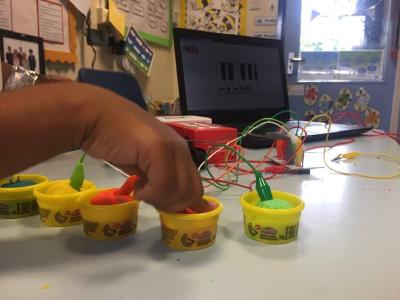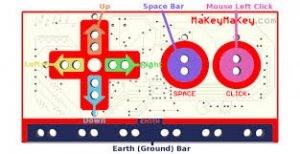
The world of music technology is fast paced, exciting and continues to evolve rapidly. While it does not replace traditional concepts of music teaching, it offers 21st century tools to enhance and expand the learning experience.
As Ruth was one of many workshop leaders for many of Decibels’ innovative projects in the past, she was more than happy to take on the mantle for this project – the theme was “Creating Music through technology”, sponsored by the Sobell Foundation.
Her first stop was at Stoke Mandeville Combined School in Aylesbury where they have a Teacher of the Deaf and a resource base for deaf/hard of hearing children. She introduced the base to the world of the brilliant Makey-Makey kits. For them, she felt that this would be a great hands-on and tactile introduction to sound and technology, as well as allowing scope for their own creative ideas.
If you haven’t heard of Makey Makey, it basically turns everyday objects into touchpads with sound output by attaching the kit to said objects and to the computer in turn and then utilizing many apps and games on the internet. As the participants sat around the table, she showed them the pretty printed ‘Makey Makey’ circuit boards which she then connected up to a computer via a USB cable. Then supplementary wires with crocodile clips on the terminals would run from the Makey Makey to conductive objects such as playdough, bananas, aluminium foil, coins and such.

It was important to learn about building a circuit which starts with attaching the ‘earth’ wire to our bodies. We made a foil wrist band and used a crocodile clip to bite onto the foil touching our skin. This meant that we were hands free to touch and play, as well as unleash our imaginations.
The fun part was exploring which conductive objects can conduct electricity and non-conductive objects known as insulators (e.g. plastic, dry tissues, cardboard). All stuff around us is made of atoms and inside these atoms are the amazing bits of stuff that can carry electricity. They are called electrons. In some materials, like plastic, these electrons are tied closely to the atom and don’t want to move. Objects made of this kind of atom can’t conduct electricity. In most metals though, the atoms have looser electrons that can move more easily and this means they can carry electricity.
Here are the many ideas we came up with:
Banana Piano
Playdough Ball
Pac-Man game with apple
Musical Leaves
Haptic technology was introduced which are body worn devices that can transmit sound by means of vibrations.